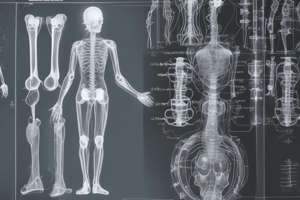Podcast
Questions and Answers
What is the main function of an intensifying screen in a film-screen receptor?
What is the main function of an intensifying screen in a film-screen receptor?
- To enhance the radiographic film's sensitivity
- To convert X-ray energy into visible light (correct)
- To convert X-ray energy into digital signals
- To reduce the patient dose
What is an advantage of digital receptors over film-screen receptors?
What is an advantage of digital receptors over film-screen receptors?
- Lower sensitivity
- Higher patient dose
- Limited dynamic range
- Improved dynamic range (correct)
What is the primary cause of size distortion in radiography?
What is the primary cause of size distortion in radiography?
- X-ray beam angulation or divergence
- Receptor curvature or non-uniformity
- Patient movement or positioning errors
- Object-to-receptor distance (correct)
What is a consequence of distortion in radiography?
What is a consequence of distortion in radiography?
How do smaller pixels and higher resolution affect distortion in digital radiography?
How do smaller pixels and higher resolution affect distortion in digital radiography?
What is a characteristic of digital radiography receptors?
What is a characteristic of digital radiography receptors?
What is a type of distortion that occurs due to unequal magnification or receptor curvature?
What is a type of distortion that occurs due to unequal magnification or receptor curvature?
What can introduce or correct for distortion in digital radiography, depending on the algorithm used?
What can introduce or correct for distortion in digital radiography, depending on the algorithm used?
Flashcards are hidden until you start studying
Study Notes
Radiography Image Receptors and Distortion
Image Receptors
- Film-Screen Receptors:
- Composed of a radiographic film and a intensifying screen
- Screen converts X-ray energy into visible light, which exposes the film
- Limitations: low sensitivity, high patient dose, and limited dynamic range
- Digital Receptors:
- Convert X-ray energy directly into digital signals
- Types: Computed Radiography (CR) and Digital Radiography (DR)
- Advantages: higher sensitivity, lower patient dose, and improved dynamic range
Distortion in Radiography
- Types of Distortion:
- Size Distortion: Enlargement or reduction of image size due to object-to-receptor distance
- Shape Distortion: Alteration of object shape due to unequal magnification or receptor curvature
- Position Distortion: Shift of image position due to receptor misalignment or object movement
- Causes of Distortion:
- Object-to-receptor distance
- Receptor curvature or non-uniformity
- X-ray beam angulation or divergence
- Patient movement or positioning errors
- Effects of Distortion:
- Diagnostic accuracy and confidence
- Measurement accuracy (e.g., bone length or density)
- Image quality and aesthetics
Factors Affecting Distortion in Digital Radiography
- Pixel Size and Resolution: Smaller pixels and higher resolution reduce distortion
- Detector Element Size and Shape: Larger elements and irregular shapes can increase distortion
- Receptor Design and Material: Curved or non-uniform receptors can introduce distortion
- Image Processing Algorithms: Can introduce or correct for distortion, depending on the algorithm used
Radiography Image Receptors
- Film-Screen Receptors: composed of radiographic film and intensifying screen, which converts X-ray energy into visible light, exposing the film
- Limitations of Film-Screen Receptors: low sensitivity, high patient dose, and limited dynamic range
- Digital Receptors: convert X-ray energy directly into digital signals, with advantages of higher sensitivity, lower patient dose, and improved dynamic range
- Types of Digital Receptors: Computed Radiography (CR) and Digital Radiography (DR)
Distortion in Radiography
Types of Distortion
- Size Distortion: enlargement or reduction of image size due to object-to-receptor distance
- Shape Distortion: alteration of object shape due to unequal magnification or receptor curvature
- Position Distortion: shift of image position due to receptor misalignment or object movement
Causes of Distortion
- Object-to-receptor distance
- Receptor curvature or non-uniformity
- X-ray beam angulation or divergence
- Patient movement or positioning errors
Effects of Distortion
- Diagnostic accuracy and confidence
- Measurement accuracy (e.g., bone length or density)
- Image quality and aesthetics
Factors Affecting Distortion in Digital Radiography
Detector Design and Properties
- Pixel Size and Resolution: smaller pixels and higher resolution reduce distortion
- Detector Element Size and Shape: larger elements and irregular shapes can increase distortion
Receptor Design and Material
- Curved or non-uniform receptors can introduce distortion
Image Processing
- Image processing algorithms can introduce or correct for distortion, depending on the algorithm used
Studying That Suits You
Use AI to generate personalized quizzes and flashcards to suit your learning preferences.




